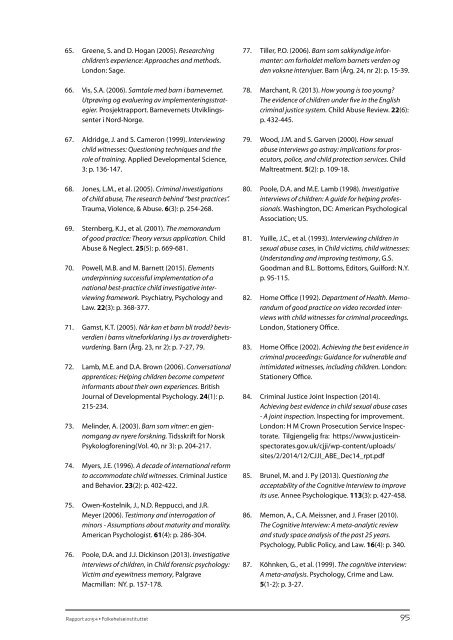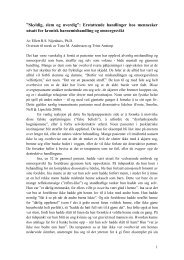rapport 2015:4
641aa6d88d
641aa6d88d
You also want an ePaper? Increase the reach of your titles
YUMPU automatically turns print PDFs into web optimized ePapers that Google loves.
65. Greene, S. and D. Hogan (2005). Researching<br />
children’s experience: Approaches and methods.<br />
London: Sage.<br />
66. Vis, S.A. (2006). Samtale med barn i barnevernet.<br />
Utprøving og evaluering av implementeringsstrategier.<br />
Prosjekt<strong>rapport</strong>. Barnevernets Utviklingssenter<br />
i Nord-Norge.<br />
67. Aldridge, J. and S. Cameron (1999). Interviewing<br />
child witnesses: Questioning techniques and the<br />
role of training. Applied Developmental Science,<br />
3: p. 136-147.<br />
68. Jones, L.M., et al. (2005). Criminal investigations<br />
of child abuse, The research behind “best practices”.<br />
Trauma, Violence, & Abuse. 6(3): p. 254-268.<br />
69. Sternberg, K.J., et al. (2001). The memorandum<br />
of good practice: Theory versus application. Child<br />
Abuse & Neglect. 25(5): p. 669-681.<br />
70. Powell, M.B. and M. Barnett (<strong>2015</strong>). Elements<br />
underpinning successful implementation of a<br />
national best-practice child investigative interviewing<br />
framework. Psychiatry, Psychology and<br />
Law. 22(3): p. 368-377.<br />
71. Gamst, K.T. (2005). Når kan et barn bli trodd? bevisverdien<br />
i barns vitneforklaring i lys av troverdighetsvurdering.<br />
Barn (Årg. 23, nr 2): p. 7-27, 79.<br />
72. Lamb, M.E. and D.A. Brown (2006). Conversational<br />
apprentices: Helping children become competent<br />
informants about their own experiences. British<br />
Journal of Developmental Psychology. 24(1): p.<br />
215-234.<br />
73. Melinder, A. (2003). Barn som vitner: en gjennomgang<br />
av nyere forskning. Tidsskrift for Norsk<br />
Psykologforening(Vol. 40, nr 3): p. 204-217.<br />
74. Myers, J.E. (1996). A decade of international reform<br />
to accommodate child witnesses. Criminal Justice<br />
and Behavior. 23(2): p. 402-422.<br />
75. Owen-Kostelnik, J., N.D. Reppucci, and J.R.<br />
Meyer (2006). Testimony and interrogation of<br />
minors - Assumptions about maturity and morality.<br />
American Psychologist. 61(4): p. 286-304.<br />
76. Poole, D.A. and J.J. Dickinson (2013). Investigative<br />
interviews of children, in Child forensic psychology:<br />
Victim and eyewitness memory, Palgrave<br />
Macmillan: NY. p. 157-178.<br />
77. Tiller, P.O. (2006). Barn som sakkyndige informanter:<br />
om forholdet mellom barnets verden og<br />
den voksne intervjuer. Barn (Årg. 24, nr 2): p. 15-39.<br />
78. Marchant, R. (2013). How young is too young?<br />
The evidence of children under five in the English<br />
criminal justice system. Child Abuse Review. 22(6):<br />
p. 432-445.<br />
79. Wood, J.M. and S. Garven (2000). How sexual<br />
abuse interviews go astray: implications for prosecutors,<br />
police, and child protection services. Child<br />
Maltreatment. 5(2): p. 109-18.<br />
80. Poole, D.A. and M.E. Lamb (1998). Investigative<br />
interviews of children: A guide for helping professionals.<br />
Washington, DC: American Psychological<br />
Association; US.<br />
81. Yuille, J.C., et al. (1993). Interviewing children in<br />
sexual abuse cases, in Child victims, child witnesses:<br />
Understanding and improving testimony, G.S.<br />
Goodman and B.L. Bottoms, Editors, Guilford: N.Y.<br />
p. 95-115.<br />
82. Home Office (1992). Department of Health. Memorandum<br />
of good practice on video recorded interviews<br />
with child witnesses for criminal proceedings.<br />
London, Stationery Office.<br />
83. Home Office (2002). Achieving the best evidence in<br />
criminal proceedings: Guidance for vulnerable and<br />
intimidated witnesses, including children. London:<br />
Stationery Office.<br />
84. Criminal Justice Joint Inspection (2014).<br />
Achieving best evidence in child sexual abuse cases<br />
- A joint inspection. Inspecting for improvement.<br />
London: H M Crown Prosecution Service Inspectorate.<br />
Tilgjengelig fra: https://www.justiceinspectorates.gov.uk/cjji/wp-content/uploads/<br />
sites/2/2014/12/CJJI_ABE_Dec14_rpt.pdf<br />
85. Brunel, M. and J. Py (2013). Questioning the<br />
acceptability of the Cognitive Interview to improve<br />
its use. Annee Psychologique. 113(3): p. 427-458.<br />
86. Memon, A., C.A. Meissner, and J. Fraser (2010).<br />
The Cognitive Interview: A meta-analytic review<br />
and study space analysis of the past 25 years.<br />
Psychology, Public Policy, and Law. 16(4): p. 340.<br />
87. Köhnken, G., et al. (1999). The cognitive interview:<br />
A meta-analysis. Psychology, Crime and Law.<br />
5(1-2): p. 3-27.<br />
Rapport <strong>2015</strong>:4 • Folkehelseinstituttet 95



